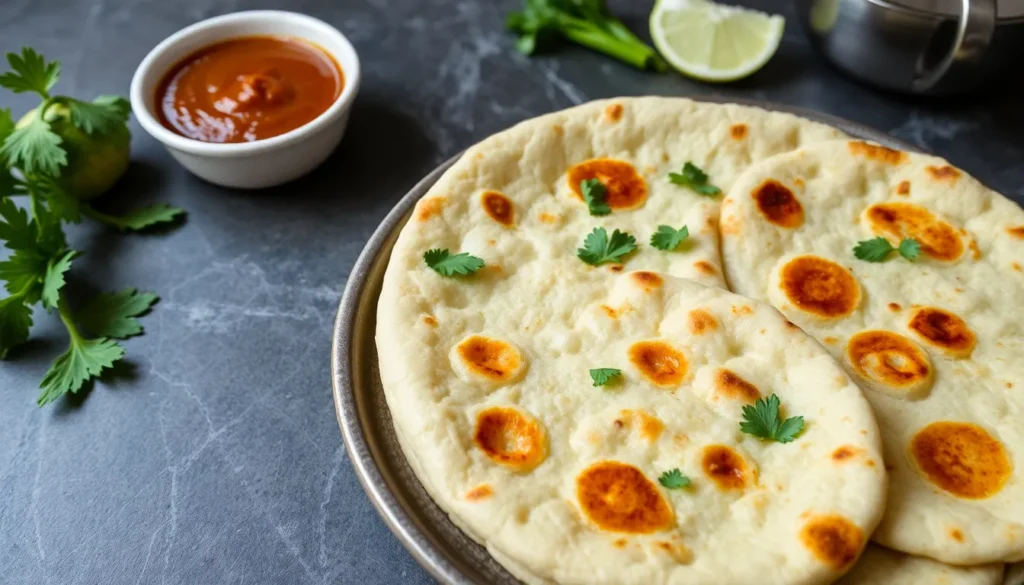World Recipes Naan

If you're a fan of global cuisine, you're likely familiar with the delightful and versatile naan bread. This Indian staple is not just a side; it's an experience in itself, perfect for pairing with a variety of dishes. Today, we'll explore the origins, variations, and a simple recipe that brings this delicious bread right to your kitchen.
What is naan?
Naan is a traditional Indian flatbread that has found its way into the hearts (and stomachs) of food lovers around the world. Originating from the Indian subcontinent, this soft and pillowy bread is typically baked in a tandoor, a clay oven that imparts a unique flavor and texture. The name "naan" is derived from the Persian word for bread, which reflects its rich cultural history.
Known for its versatility, naan can be enjoyed with various dishes, especially rich and flavorful curries. Instead of using utensils, it's common in Indian culture to tear off pieces of naan and use them to scoop up sauces and vegetables, creating an interactive dining experience. Beyond its traditional use, naan is also delicious on its own, making it a popular choice for snacks or appetizers.
Common ingredients used in naan
The beauty of naan lies in its simplicity, made with just a handful of ingredients. Here’s a breakdown of what you typically need:
- Flour: All-purpose flour is most commonly used; however, whole wheat flour can be a healthier alternative.
- Yogurt: This ingredient adds tenderness and a slight tang to the bread.
- Yeast: Essential for the bread to rise and become fluffy.
- Salt and sugar: These enhance the flavor of the bread.
- Butter or ghee: Used for brushing on top for added richness and flavor.
Exploring different types of naan
While the classic naan is a favorite, there are many variations that cater to different tastes and dietary preferences:
- Garlic naan: Infused with minced garlic and often topped with cilantro, this variation is perfect for garlic lovers.
- Butter naan: Rich and indulgent, this variant is brushed generously with butter before serving.
- Cheese naan: Stuffed with cheese, this is a popular choice for those who enjoy a gooey, savory treat.
- Plain naan: The simplest version, allowing the natural flavors to shine through.
Each of these varieties adds its unique twist to the traditional recipe, making naan an incredibly adaptable bread.
How to make naan at home: a simple recipe
Creating naan at home is easier than you might think. Here’s a straightforward recipe that doesn’t require a tandoor, making it accessible to everyone:
Ingredients (for 3-6 naan)
- 2 cups of all-purpose flour
- 1 teaspoon of dry yeast
- 1 cup of plain yogurt (unsweetened)
- 1 teaspoon of salt
- 2 teaspoons of sugar
- Water (as needed)
- 1 tablespoon of melted butter (for brushing)
- A handful of cilantro (optional)
- 1 clove of garlic (optional)
Step-by-step preparation
- Combine the yeast and sugar with 1/8 cup of warm water. Let it sit for about 5 minutes until it gets frothy.
- In a mixing bowl, combine the flour, salt, and yogurt. Slowly add the yeast mixture, mixing until it forms a dough. If it feels too dry, add a little more water, but be cautious not to make it too sticky.
- Knead the dough for about 5-7 minutes until smooth. Cover it with a damp cloth and let it rest at room temperature for 30 minutes.
- After resting, divide the dough into small balls and flatten them into discs, approximately 8 inches in diameter.
- Heat a non-stick skillet over medium heat. Brush it lightly with melted butter. Place the naan on the skillet and cook for about 1-2 minutes on each side, until it puffs up and has golden spots.
- Once cooked, brush with more melted butter and sprinkle with chopped cilantro if desired.
Tips for perfect naan
Making naan can be a fun and rewarding experience. Here are a few tips to ensure you achieve the best results:
- Allow the dough to rest adequately. This helps develop gluten, making the naan softer.
- Experiment with different toppings, such as sesame seeds or herbs, to personalize your naan.
- For a unique flavor, try adding spices like cumin or coriander to the dough.
- Serve naan warm, as it tends to harden when cooled. If you have leftovers, reheat them in a skillet.
Cooking naan without traditional tools
While naan is traditionally cooked in a tandoor, you can achieve excellent results using a stovetop. Here’s how:
Using a heavy skillet or cast-iron pan allows for even heat distribution. Ensure the pan is well-preheated to create those delightful brown spots on your naan. The key is to maintain a medium to low heat to cook the naan thoroughly without burning the outside.
Watch this quick video to see the naan-making process in action:
The cultural significance of naan
Naan is more than just a bread; it carries cultural significance in Indian cuisine. Serving naan with a meal is customary, often symbolizing hospitality and warmth. It is enjoyed across various regions and even adapted into local cuisines, showcasing its versatility.
In addition to Indian cuisine, naan has made its way into global food culture, appearing on menus in restaurants worldwide. It serves as a canvas for various toppings, fillings, and pairings, making it a beloved choice for many.
Conclusion
Making naan at home can be a delightful culinary adventure that brings a taste of India to your kitchen. With its rich history, diverse variations, and simple preparation, naan is sure to impress your family and friends. So roll up your sleeves, gather your ingredients, and enjoy the process of creating this delicious bread that transcends borders and unites people around the table.




Deja una respuesta